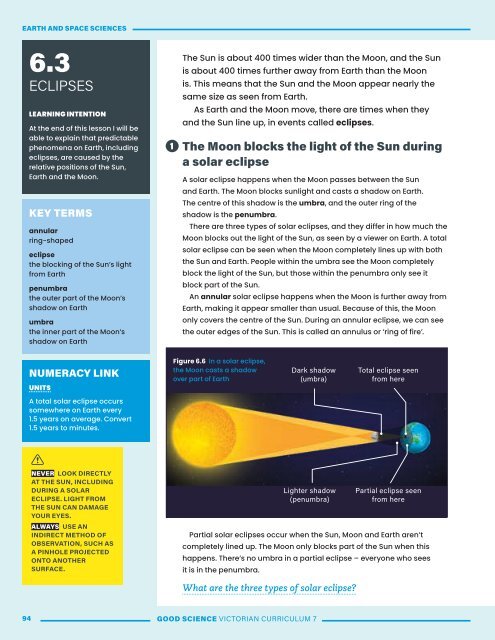Good Science Victorian Curriculum Year 7
Digital sample of Matilda's newest publication, Good Science Victorian Curriculum Year, authored by Emma Craven and Aaron Elias. For more information visit www.matildaeducation.com.au or email Katrina Tucker, katrinatucker@matildaed.com.au
Digital sample of Matilda's newest publication, Good Science Victorian Curriculum Year, authored by Emma Craven and Aaron Elias. For more information visit www.matildaeducation.com.au or email Katrina Tucker, katrinatucker@matildaed.com.au
Create successful ePaper yourself
Turn your PDF publications into a flip-book with our unique Google optimized e-Paper software.
EARTH AND SPACE SCIENCES<br />
6.3<br />
ECLIPSES<br />
LEARNING INTENTION<br />
At the end of this lesson I will be<br />
able to explain that predictable<br />
phenomena on Earth, including<br />
eclipses, are caused by the<br />
relative positions of the Sun,<br />
Earth and the Moon.<br />
KEY TERMS<br />
annular<br />
ring-shaped<br />
eclipse<br />
the blocking of the Sun’s light<br />
from Earth<br />
penumbra<br />
the outer part of the Moon’s<br />
shadow on Earth<br />
umbra<br />
the inner part of the Moon’s<br />
shadow on Earth<br />
1<br />
The Sun is about 400 times wider than the Moon, and the Sun<br />
is about 400 times further away from Earth than the Moon<br />
is. This means that the Sun and the Moon appear nearly the<br />
same size as seen from Earth.<br />
As Earth and the Moon move, there are times when they<br />
and the Sun line up, in events called eclipses.<br />
The Moon blocks the light of the Sun during<br />
a solar eclipse<br />
A solar eclipse happens when the Moon passes between the Sun<br />
and Earth. The Moon blocks sunlight and casts a shadow on Earth.<br />
The centre of this shadow is the umbra, and the outer ring of the<br />
shadow is the penumbra.<br />
There are three types of solar eclipses, and they differ in how much the<br />
Moon blocks out the light of the Sun, as seen by a viewer on Earth. A total<br />
solar eclipse can be seen when the Moon completely lines up with both<br />
the Sun and Earth. People within the umbra see the Moon completely<br />
block the light of the Sun, but those within the penumbra only see it<br />
block part of the Sun.<br />
An annular solar eclipse happens when the Moon is further away from<br />
Earth, making it appear smaller than usual. Because of this, the Moon<br />
only covers the centre of the Sun. During an annular eclipse, we can see<br />
the outer edges of the Sun. This is called an annulus or ‘ring of fire’.<br />
NUMERACY LINK<br />
UNITS<br />
Figure 6.6 In a solar eclipse,<br />
the Moon casts a shadow<br />
over part of Earth<br />
Dark shadow<br />
(umbra)<br />
Total eclipse seen<br />
from here<br />
A total solar eclipse occurs<br />
somewhere on Earth every<br />
1.5 years on average. Convert<br />
1.5 years to minutes.<br />
NEVER LOOK DIRECTLY<br />
AT THE SUN, INCLUDING<br />
DURING A SOLAR<br />
ECLIPSE. LIGHT FROM<br />
THE SUN CAN DAMAGE<br />
YOUR EYES.<br />
ALWAYS USE AN<br />
INDIRECT METHOD OF<br />
OBSERVATION, SUCH AS<br />
A PINHOLE PROJECTED<br />
ONTO ANOTHER<br />
SURFACE.<br />
Lighter shadow<br />
(penumbra)<br />
Partial eclipse seen<br />
from here<br />
Partial solar eclipses occur when the Sun, Moon and Earth aren’t<br />
completely lined up. The Moon only blocks part of the Sun when this<br />
happens. There’s no umbra in a partial eclipse – everyone who sees<br />
it is in the penumbra.<br />
What are the three types of solar eclipse?<br />
94 GOOD SCIENCE VICTORIAN CURRICULUM 7


















